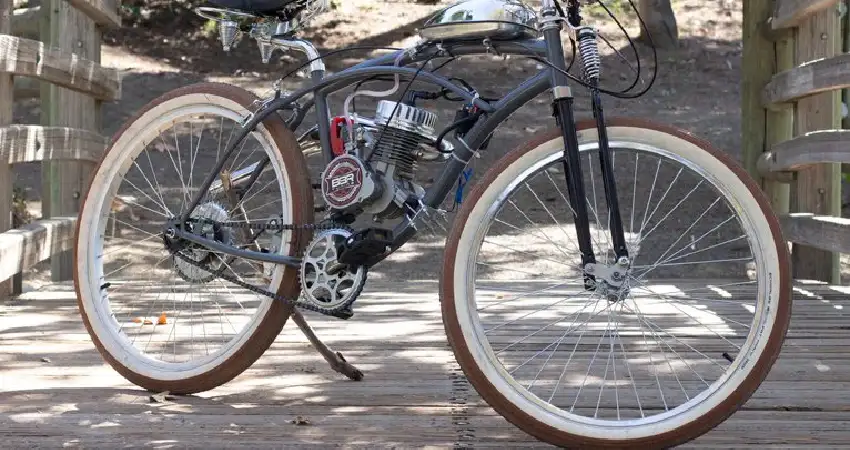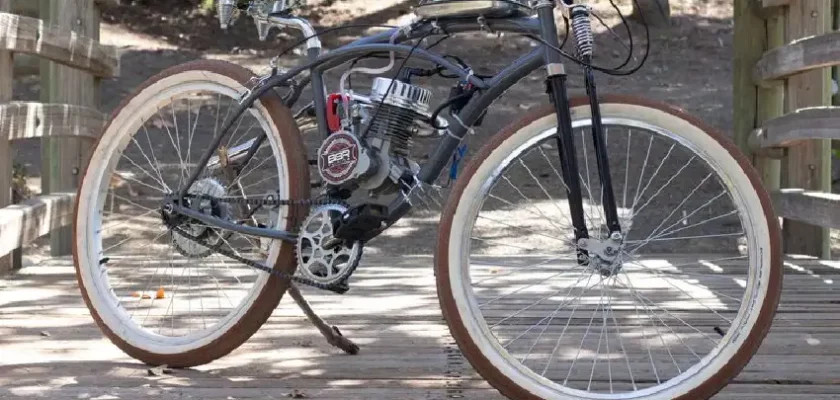Have you ever wondered how a motorized bike works? Well, you’re not alone! Many people are curious about the inner workings of this popular mode of transportation. In this article, we will delve into the fascinating realm of motorized bikes and uncover the secrets behind their functionality.
But let’s not keep you waiting for the answer to your burning question: how does a motorized bike work? Simply put, a motorized bike combines the best of both worlds – the pedal power of a conventional bicycle and the added boost of a motor.
It’s like having an extra pair of legs to propel you forward, allowing for a faster and more effortless ride.
Now that we’ve piqued your curiosity, let’s dive deeper into the mechanics of a motorized bike and explore the components that make it tick. Get ready to unravel the mysteries of how does a motorized bike works!
How Does a Motorized Bike Work?

Motorized bikes, also known as motor bicycles or motorized bicycles, have gained popularity in recent years as a more fuel-efficient and environmentally friendly alternative to traditional motorcycles or cars.
They combine the convenience of a bicycle with the power of a small engine to provide an efficient and enjoyable mode of transportation. But how exactly does a motorized bike work?
The Basic Components of a Motorized Bike
To understand how a motorized bike works, let’s first take a look at its basic components:
1. Bicycle Frame: Like a regular bicycle, a motorized bike consists of a sturdy frame that provides the structural support for the entire vehicle.
2. Motor: The heart of a motorized bike is the engine. It can be either a two-stroke or a four-stroke engine, depending on the model. The motor generates power and propels the bike forward.
3. Fuel Tank: Motorized bikes typically have a small fuel tank, usually located in the frame or attached to it. It stores the fuel needed to power the engine.
4. Exhaust: The exhaust system is responsible for removing the combustion gases produced by the engine. It helps reduce noise and emissions.
5. Transmission: The transmission transfers power from the engine to the rear wheel. It consists of a chain drive or a belt drive system.
6. Throttle: The throttle is a control lever that regulates the amount of fuel and air mixture supplied to the engine. It determines the speed of the motorized bike.
7. Brakes: Just like regular bicycles, motorized bikes have brakes to slow down or stop the vehicle. They can be either mechanical or hydraulic.
The Working Principle of a Motorized Bike
Now that we are familiar with the basic components, let’s dive into the working principle of a motorized bike:
1. Combustion: The engine in a motorized bike relies on an internal combustion process to generate power. In a two-stroke engine, the combustion happens in every revolution of the engine, while in a four-stroke engine, it occurs every two revolutions.
2. Fuel and Air Mixture: The fuel tank supplies the engine with a mixture of fuel (usually gasoline) and air. This mixture is typically regulated by a carburetor or a fuel injection system. The ideal ratio of fuel to air ensures efficient combustion.
3. Ignition Sparks: Once the fuel and air mixture is in the combustion chamber, a spark plug creates a spark that ignites the mixture. This ignition creates an explosion, which exerts pressure on the piston.
4. Piston Movement: The force generated by the explosion pushes the piston down. The up-and-down movement of the piston is responsible for transferring power from the engine to the transmission.
5. Transmission and Drivetrain: The transmission, typically a chain or belt drive system, transfers the power from the engine to the rear wheel. It converts the rotational motion of the engine into linear motion of the bike’s rear wheel, propelling the bike forward.
6. Throttle Control: The throttle, controlled by the rider, regulates the flow of fuel and air to the engine. By adjusting the throttle, the rider can increase or decrease the engine’s power output, thereby controlling the speed of the motorized bike.
7. Braking System: To slow down or stop the motorized bike, the rider can apply the brakes. Mechanical or hydraulic systems press brake pads against the wheel rims or disks, creating friction and slowing down the bike.
8. Exhaust System: As the fuel mixture burns, exhaust gases are produced. These gases are expelled through the exhaust system, which consists of a muffler and a series of pipes. The exhaust system helps reduce noise and emissions.
The Advantages of Motorized Bikes
Motorized bikes offer several advantages over traditional vehicles. Here are some notable benefits:
1. Fuel Efficiency: Motorized bikes are highly fuel-efficient, allowing riders to save money on fuel costs. With the rising prices of gasoline, this is a significant advantage.
2. Environmental Friendliness: Compared to cars or motorcycles, motorized bikes produce less pollution and have a lower carbon footprint. They can contribute to reducing air pollution and lowering greenhouse gas emissions.
3. Convenience and Agility: Motorized bikes combine the convenience of bicycles with the added power of an engine. They provide a flexible and agile mode of transportation, especially in urban areas with heavy traffic.
4. Cost-Efficiency: Motorized bikes are generally more affordable than cars or motorcycles. They require less maintenance and have lower insurance costs. Additionally, they are often exempt from parking fees or registration requirements.
5. Physical Activity: While motorized bikes provide the option of motorized propulsion, riders can still choose to pedal when desired. This allows for physical activity and exercise while commuting.
6. Accessibility: Motorized bikes can be a great mode of transportation for people who may have physical limitations or difficulty pedaling for long distances. The motorized assistance makes commuting easier and more accessible for a wider range of individuals.
Frequently Asked Questions
1. How does a motorized bike work?
A motorized bike works by combining a bicycle with an engine that provides power. The engine can be either electric or gasoline powered, and it propels the bike forward when activated. The engine transfers power to the wheels through a transmission system.
2. What types of engines can power a motorized bike?
Motorized bikes can be powered by either electric or gasoline engines. Electric motors are quieter and more environmentally friendly, while gasoline engines offer greater power and range.
3. How is power transmitted from the engine to the wheels?
Power from the engine is transmitted to the wheels of a motorized bike through a transmission system. In most cases, this involves a chain or belt drive that connects the engine’s output shaft to the rear wheel. The transmission allows the rider to control the bike’s speed.
4. How is an electric motorized bike different from a gas-powered one?
Electric motorized bikes use rechargeable batteries to power the electric motor, while gas-powered bikes rely on gasoline or other fuels to run the engine. Electric bikes are generally quieter, require less maintenance, and produce zero emissions, whereas gas-powered bikes are louder and emit exhaust gases.
5. Are motorized bikes legal to ride on public roads?
The legal status of motorized bikes varies depending on the jurisdiction. In some places, they may require registration, licensing, and compliance with certain requirements such as speed limits or engine size. It is important to check local laws and regulations before riding a motorized bike on public roads.
Final Thoughts
In conclusion, understanding how a motorized bike works is essential for enthusiasts and riders alike. The mechanics behind a motorized bike involve a combination of traditional bicycle components and an added motor system.
This system is typically powered by a rechargeable battery and is designed to provide an extra boost to the rider’s pedal power.
By transferring energy from the battery to the motor, the motorized bike is able to assist the rider in pedaling up hills or accelerating on flat surfaces. The electric motor works in harmony with the traditional bike components, allowing for a seamless and enjoyable riding experience.
Overall, grasping the inner workings of a motorized bike sheds light on the symbiotic relationship between human power and electric assistance. Consequently, it enables riders to make informed decisions and fully appreciate the benefits of this innovative mode of transportation.

